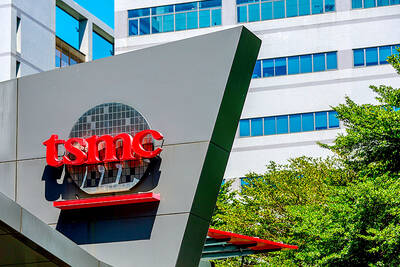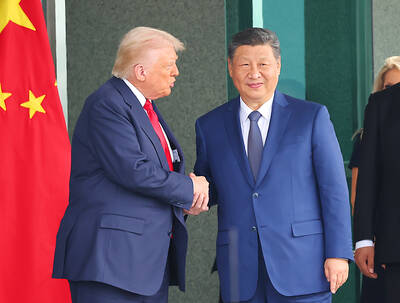Skyrocketing prices of tomatoes, potatoes and onions are putting food out of reach in flood-ravaged Pakistan, raising the specter of inflation reaching 30 percent, spurring more monetary tightening.
The South Asian nation already reeling from dwindling currency reserves and the fastest inflation in almost five decades faces a food shortage after torrential rains submerged one-third of the country and destroyed crops. Eight more districts were added at the weekend to the country’s calamity list of 80 areas hit by floods.
Onions were sold at 300 rupees (US$1.36) per kilogram from 50 rupees before the floods, said Ali Asghar Londer, one of the thousands living in evacuation tents in Dadu, a city near the western bank of the Indus River.

Photo: AP
Dadu has seen the biggest damage to its rice and onion production.
The cost of potatoes have climbed by 400 percent to 100 rupees per kilogram, tomatoes were up 300 percent to 400 rupees per kilogram, while ghee, a fat used for cooking, has surged 400 percent, Londer said last week.
Elsewhere, supplies of dairy and meat were also affected as warehouses got flooded.
The surge in food prices would add stress to an already fragile and politically divided economy that has just been regaining some funding strength after securing a US$1.16 billion IMF bailout and US$9 billion in pledges from Qatar, Saudi Arabia and the United Arab Emirates.
The floods, which are estimated to have caused an estimated US$10 billion worth of damage, has claimed the lives of more than 1,300 people and forced half a million into camps. It has also submerged large swathes of farmland and flushed away crops in a country where agriculture accounts for about a fifth of the economy.
While Pakistani Minister for Finance, Revenue and Economic Affairs Miftah Ismail was sanguine on Saturday, saying vegetable prices are coming off and that inflation at a 47-year-high is close to its peak and likely average at 15 percent this year, analysts were not as optimistic.
“The main concern from the floods is the impact on inflation,” JS Global Capital Ltd research head Amreen Soorani said. “Food shortage from floods the last time in 2010 almost doubled food inflation in two months. We’re already in a high inflationary environment, making the scenario even more difficult.”
Consumer price gains quickened to 27.26 percent last month, rising for a sixth straight month before the full effects of the flooding is felt. Food inflation, that makes up one-third of the basket, climbed to 29.5 percent last month. The calculus does not include yet the full effects of energy prices rising by 50 percent, a condition of the IMF loan.
Inflation could accelerate to 30 percent in the coming two months and that would take the average price gains this fiscal year to 23 to 24 percent, surpassing the central bank’s estimate of 18 to 20 percent, Ismail Iqbal Securities Pvt research head Fahad Rauf said.
Former Pakistani prime minister Imran Khan — who was ousted in April, yet remains popular — is waging a fierce campaign to press for elections, and the devastating floods are stoking public anger.
“It’s been four days that our children are sitting on the road awaiting food and shelter. Our children are dying,” said Mohammad Sharif, 40, a protest leader who last week blocked one of the nation’s main highways for a few hours after not getting any relief goods. “We have no food, no tents, nothing.”

RUN IT BACK: A succesful first project working with hyperscalers to design chips encouraged MediaTek to start a second project, aiming to hit stride in 2028 MediaTek Inc (聯發科), the world’s biggest smartphone chip supplier, yesterday said it is engaging a second hyperscaler to help design artificial intelligence (AI) accelerators used in data centers following a similar project expected to generate revenue streams soon. The first AI accelerator project is to bring in US$1 billion revenue next year and several billion US dollars more in 2027, MediaTek chief executive officer Rick Tsai (蔡力行) told a virtual investor conference yesterday. The second AI accelerator project is expected to contribute to revenue beginning in 2028, Tsai said. MediaTek yesterday raised its revenue forecast for the global AI accelerator used

Taiwan Semiconductor Manufacturing Co (TSMC, 台積電) has secured three construction permits for its plan to build a state-of-the-art A14 wafer fab in Taichung, and is likely to start construction soon, the Central Taiwan Science Park Bureau said yesterday. Speaking with CNA, Wang Chun-chieh (王俊傑), deputy director general of the science park bureau, said the world’s largest contract chipmaker has received three construction permits — one to build a fab to roll out sophisticated chips, another to build a central utility plant to provide water and electricity for the facility and the other to build three office buildings. With the three permits, TSMC

TEMPORARY TRUCE: China has made concessions to ease rare earth trade controls, among others, while Washington holds fire on a 100% tariff on all Chinese goods China is effectively suspending implementation of additional export controls on rare earth metals and terminating investigations targeting US companies in the semiconductor supply chain, the White House announced. The White House on Saturday issued a fact sheet outlining some details of the trade pact agreed to earlier in the week by US President Donald Trump and Chinese President Xi Jinping (習近平) that aimed to ease tensions between the world’s two largest economies. Under the deal, China is to issue general licenses valid for exports of rare earths, gallium, germanium, antimony and graphite “for the benefit of US end users and their suppliers

Dutch chipmaker Nexperia BV’s China unit yesterday said that it had established sufficient inventories of finished goods and works-in-progress, and that its supply chain remained secure and stable after its parent halted wafer supplies. The Dutch company suspended supplies of wafers to its Chinese assembly plant a week ago, calling it “a direct consequence of the local management’s recent failure to comply with the agreed contractual payment terms,” Reuters reported on Friday last week. Its China unit called Nexperia’s suspension “unilateral” and “extremely irresponsible,” adding that the Dutch parent’s claim about contractual payment was “misleading and highly deceptive,” according to a statement